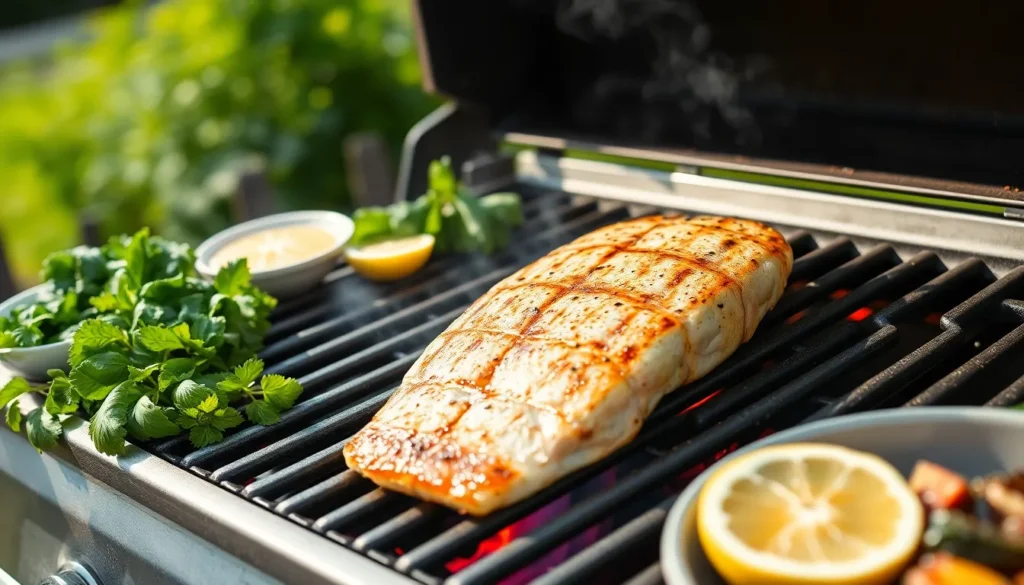Grilled tilefish transforms this underrated Atlantic treasure into a restaurant-quality masterpiece right on your backyard grill. We’ve discovered that tilefish’s firm white flesh and mild flavor make it absolutely perfect for grilling – it won’t fall apart like more delicate fish and accepts bold seasonings beautifully.
This versatile fish has been a well-kept secret among commercial fishermen for decades but it’s finally gaining recognition in home kitchens across America. We love how tilefish’s meaty texture stands up to high heat while developing those coveted grill marks that make any dish Instagram-worthy.
Our foolproof grilled tilefish recipe delivers perfectly flaky fish with a slightly smoky char that’ll have your family asking for seconds. Whether you’re hosting a summer barbecue or looking for a healthy weeknight dinner that’s ready in under 20 minutes we’ll show you exactly how to grill tilefish to perfection every single time.
What Is Tilefish and Why Grill It?
Tilefish represents one of the ocean’s most underappreciated treasures with its pristine white flesh and naturally sweet flavor profile. We often describe this remarkable fish as having a texture similar to grouper or mahi-mahi but with a more delicate taste that absorbs marinades and seasonings beautifully. Found primarily in deeper Atlantic waters tilefish has been a well-kept secret among commercial fishermen for decades.
The species earned its name from its unique habit of building elaborate tile-like shelters on the ocean floor using shells stones and debris. Golden tilefish which we recommend most for grilling can grow quite large with some specimens reaching up to 50 pounds though the ideal cooking size ranges between 2 to 10 pounds.
Grilling brings out the best qualities in tilefish through several key advantages. The firm texture holds together exceptionally well on grill grates preventing the frustrating flaking and falling apart that plagues more delicate fish varieties. High heat creates a beautiful caramelized exterior while keeping the interior moist and flaky.
We love how tilefish develops those coveted grill marks that add both visual appeal and smoky flavor complexity. The natural oils in the fish create excellent browning without requiring excessive added fats. Unlike some fish that can become dry when grilled tilefish maintains its moisture content thanks to its natural fat distribution.
The mild flavor profile makes tilefish incredibly versatile for various seasoning approaches. We can go bold with spicy rubs or keep things simple with just salt pepper and lemon. The fish acts as a perfect canvas for Mediterranean herbs Cajun spices or Asian-inspired marinades.
Sustainability also plays a role in our enthusiasm for tilefish. The species is currently well-managed with healthy population levels making it an environmentally responsible choice for conscious cooks. Most tilefish comes from domestic fisheries ensuring freshness and supporting local fishing communities.
Ingredients

This grilled tilefish recipe requires simple yet quality ingredients that enhance the fish’s natural flavor. We’ve organized our ingredient list into three categories to make preparation straightforward and efficient.
For the Tilefish
- 4 large golden tilefish fillets (or 6 fillets, 6 oz each)
- Skin-on fillets with scales removed
- Olive oil for brushing
- Kosher salt to taste
- Ground black pepper to taste
- Smoked paprika powder (optional for added depth)
For the Marinade
- Juice and zest of 1 lime
- 1 stick (1/2 cup) unsalted butter, softened to room temperature
- 1/8 cup unsweetened coconut (optional for compound butter)
- 6-8 lemon slices, thinly sliced
- 1-2 cloves garlic, minced or smashed (optional)
- Additional lemon juice for basting during grilling
For Serving
- Fresh herbs such as parsley or purple basil for garnish
- Coconut lime compound butter (optional finishing touch)
- Side dish options: braised kale salad, herby barley salad, or fresh vegetable chow chow
Equipment Needed
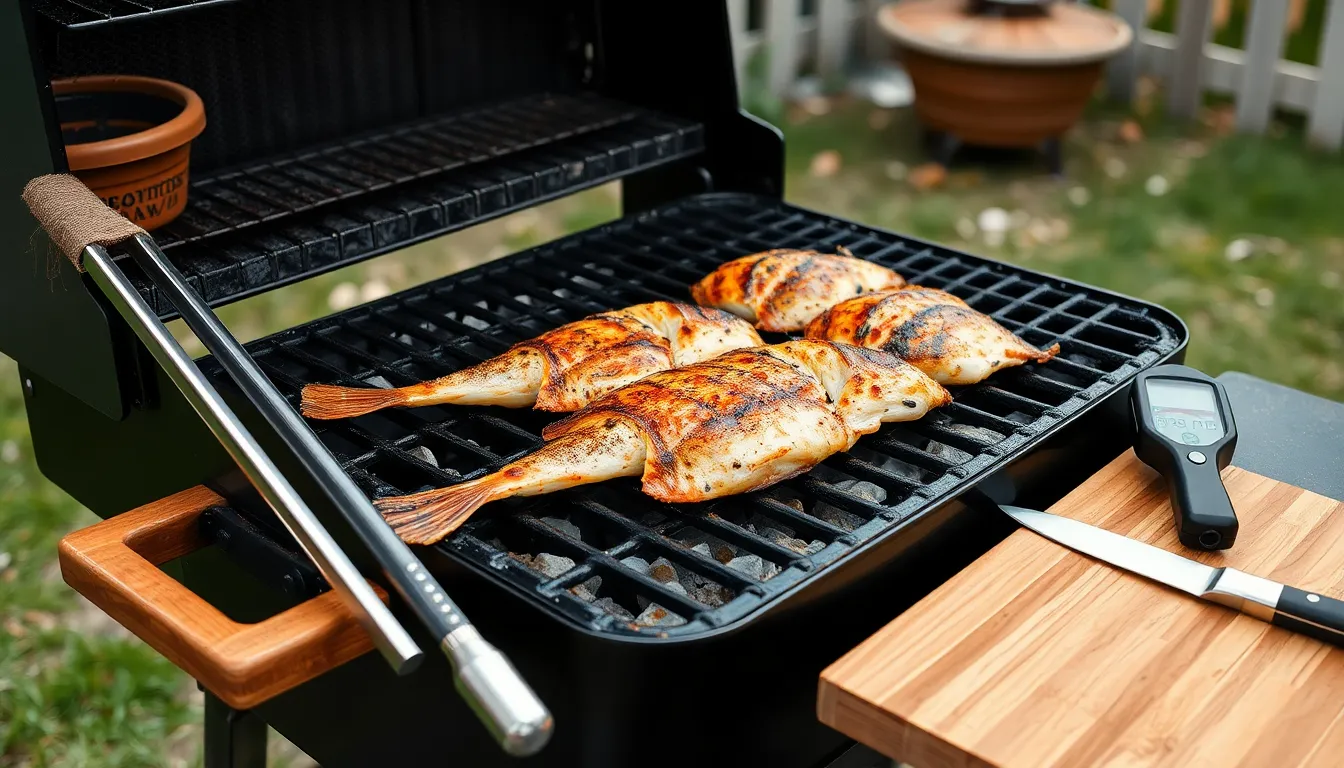
Grilling perfect tilefish requires the right tools to handle this delicate fish safely and effectively. We’ve compiled the essential equipment list to ensure your grilled tilefish turns out beautifully every time.
Grill Setup
A charcoal or gas grill serves as our primary cooking surface. We recommend preheating your grill to medium-high heat, maintaining temperatures between 350°F to 400°F for optimal cooking results.
Essential Grilling Tools
Long tongs become indispensable when handling tilefish fillets on the grill. These tools allow us to flip and move the fish safely without breaking the delicate flesh. We also need a wadded clean rag for oiling the grill grates, which prevents the fish from sticking during cooking.
Temperature Monitoring
An instant read thermometer ensures we cook the tilefish to the proper internal temperature of 145°F. This tool eliminates guesswork and guarantees food safety while preventing overcooking.
Preparation Equipment
Basic prep work requires a cutting board and sharp knife for trimming fillets and preparing garnishes. If we’re making compound butter enhancements, an immersion blender helps create smooth, well-incorporated flavored butters.
| Equipment | Purpose | Temperature/Specification |
|---|---|---|
| Grill | Primary cooking surface | 350°F to 400°F |
| Instant read thermometer | Check doneness | Target: 145°F internal |
| Long tongs | Safe fish handling | N/A |
| Clean rag | Oil grill grates | N/A |
Having these tools ready before we start cooking streamlines the grilling process and helps us achieve restaurant-quality results with our tilefish fillets.
Prep Instructions

Proper preparation sets the foundation for perfectly grilled tilefish that showcases the fish’s delicate flavor and firm texture. We’ll walk through each essential step to ensure your tilefish is ready for the grill.
Preparing the Fish
We start by selecting fresh tilefish fillets that are large and thick for optimal grilling results. Remove the fish from refrigeration and rinse each fillet under cold running water to eliminate any surface debris.
Pat the fillets completely dry using paper towels, ensuring no moisture remains on the surface. This step prevents steaming and helps achieve the desired seared exterior when grilling.
Season both sides of each fillet generously with sea salt and freshly ground black pepper. The seasoning should cover the entire surface evenly for consistent flavor throughout.
For enhanced crust development, we recommend lightly dredging the seasoned fillets in seasoned flour. This optional step creates a beautiful golden exterior when the fish meets the grill grates.
Allow the prepared fillets to rest at room temperature for 15-20 minutes before grilling. This ensures even cooking throughout the fish.
Making the Marinade
We create a compound butter that enhances the tilefish’s natural sweetness while adding bright citrus notes. Combine one stick of room temperature unsalted butter with the zest and juice of one fresh lime in a mixing bowl.
Add one teaspoon of salt and 1/8 cup of unsweetened coconut to the butter mixture. The coconut adds subtle tropical flavor that complements the fish beautifully.
Use an immersion blender to combine all ingredients until the mixture becomes smooth and well incorporated. The compound butter should have a creamy consistency without lumps.
For those preferring a traditional marinade approach, we offer an alternative option. Whisk together olive oil, salt, pepper, and fresh lemon juice in a shallow dish.
Place the prepared fillets in the marinade for a brief time, turning once to coat both sides. Avoid over-marinating as tilefish has delicate flesh that can become mushy with extended exposure to acidic ingredients.
The marinade should enhance rather than overpower the fish’s mild flavor profile. We recommend marinating for no more than 30 minutes before grilling.
Grilling Instructions
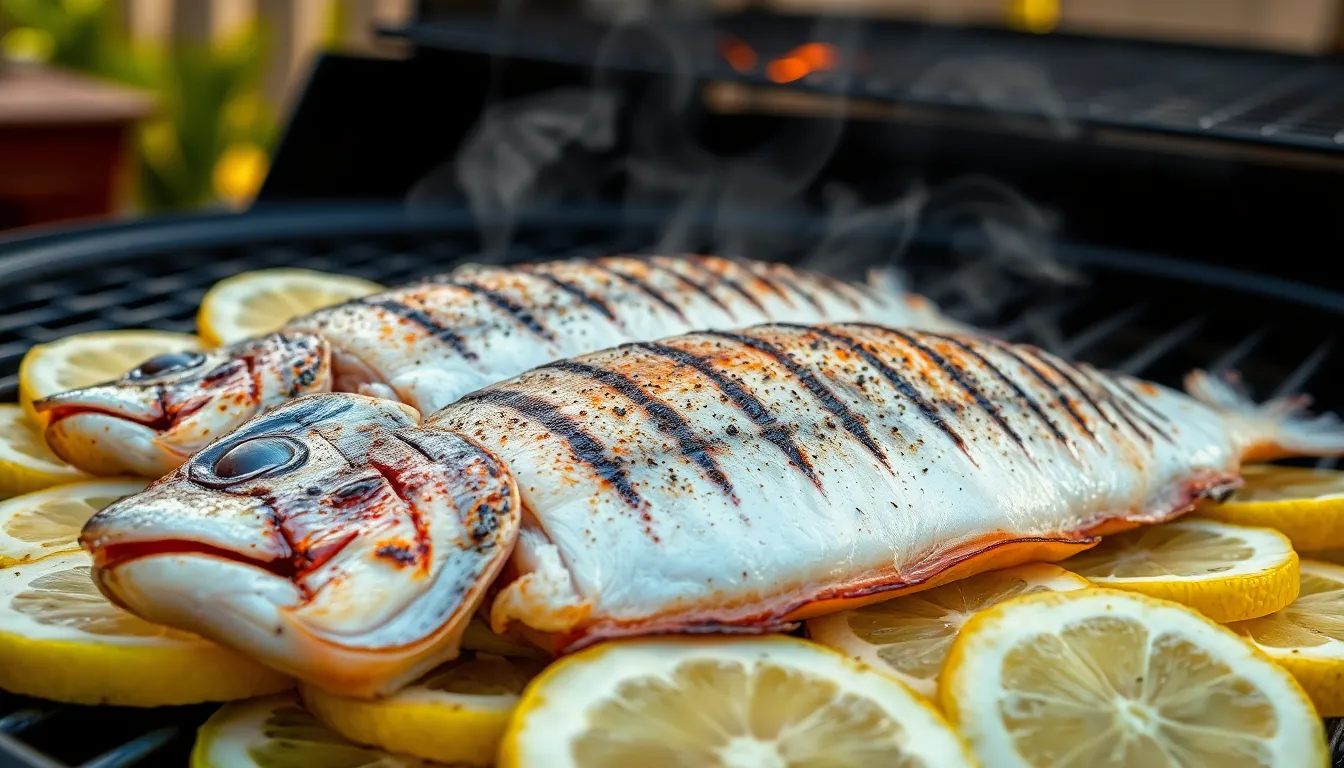
Now that we have our tilefish properly prepared and seasoned, it’s time to fire up the grill and transform these beautiful fillets into a perfectly cooked masterpiece. Following these step-by-step grilling instructions will ensure your tilefish develops that coveted smoky char while maintaining its tender, flaky interior.
Preheating the Grill
We need to preheat our grill to medium heat, targeting around 350°F (175°C) for optimal tilefish cooking. This temperature provides the perfect balance for cooking the fish through without burning the exterior. For gas grills, we’ll turn the burners to medium and allow 10-15 minutes for proper heating. Charcoal grill users should arrange coals for indirect cooking and let them burn until they’re covered with white ash.
While the grill heats, we recommend creating a bed of lemon slices on the grill grates where we’ll place our fillets. This technique prevents the delicate fish from sticking while adding subtle citrus flavor to complement the tilefish’s mild taste. The lemon slices should be thick enough to support the fillets and arranged in a pattern large enough to accommodate all pieces.
Grilling the Tilefish
Once our grill reaches the proper temperature, we’ll brush each tilefish fillet generously with olive oil or our prepared compound butter. This coating helps create that beautiful golden exterior and prevents sticking to the grates. We place the fillets diagonally across the grill over our lemon slice bed, positioning them skin side down if the skin is still attached.
Closing the grill lid immediately after placing the fish maintains consistent temperature and creates the ideal cooking environment. We keep the vents open to ensure proper airflow and temperature control throughout the cooking process. The fillets will grill for approximately 16-18 minutes without flipping, which helps maintain their structural integrity and prevents breakage.
| Grilling Timeline | Temperature | Action |
|---|---|---|
| 0-2 minutes | 350°F | Place fillets on lemon bed |
| 2-16 minutes | 350°F | Cook with lid closed |
| 16-18 minutes | 350°F | Check for doneness |
Checking for Doneness
We use an instant-read thermometer to determine when our tilefish is perfectly cooked. The internal temperature should reach 145°F (63°C) at the thickest part of the fillet for food safety and optimal texture. Inserting the thermometer horizontally into the center of the fish provides the most accurate reading.
Visual cues also help us identify properly cooked tilefish. The flesh transforms from translucent to opaque white and flakes easily when tested with a fork. We gently press the surface of the fillet, and properly cooked fish will feel firm yet yield slightly to pressure. Overcooking results in a dry, tough texture, so we remove the fillets from the grill as soon as they reach the target temperature.
Serving Suggestions
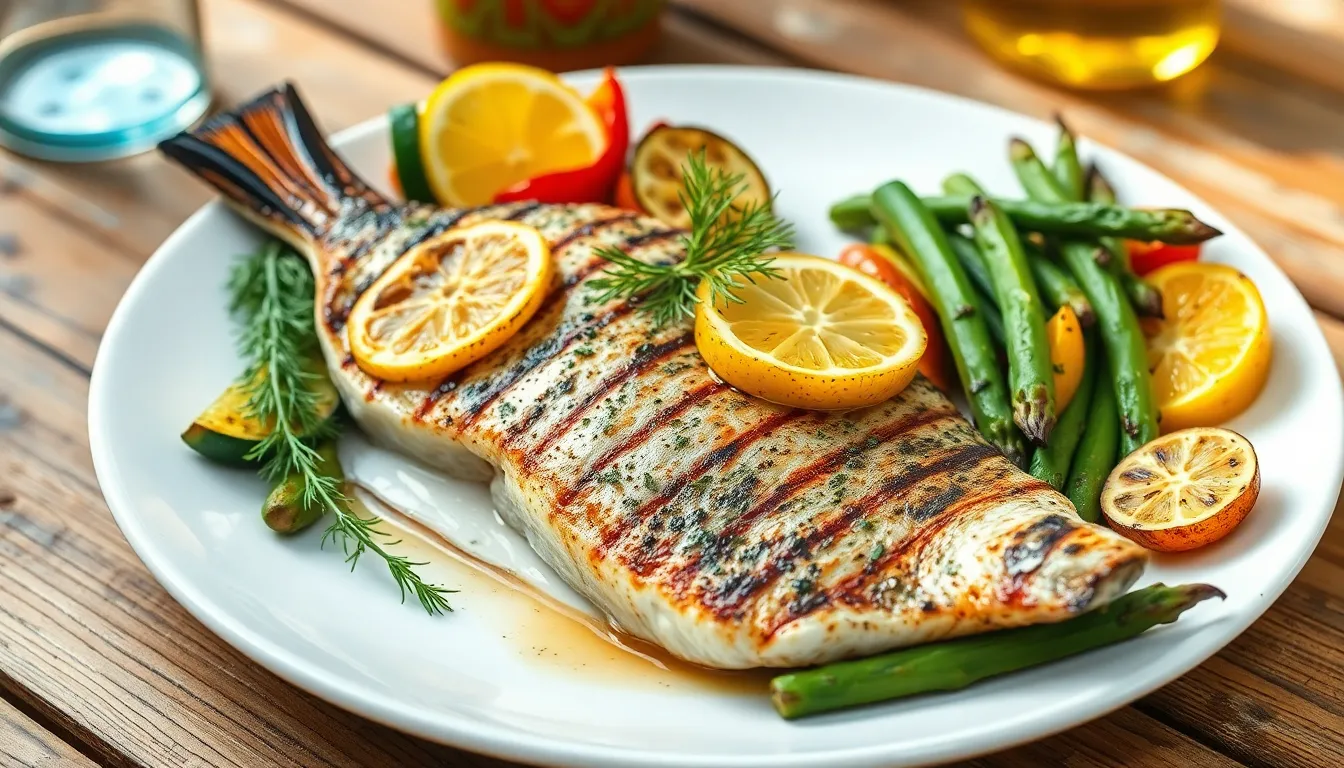
Our perfectly grilled tilefish deserves accompaniments that complement its delicate sweetness and smoky char. We recommend pairing the fish with braised kale salad and a simple herby barley salad for a balanced meal that highlights the fish’s natural flavors without overwhelming them.
The lemon slices used during grilling transform into caramelized gems that make excellent garnishes. We suggest serving these grilled lemon slices alongside the fish to enhance the citrus notes and provide an attractive presentation. Each slice delivers concentrated citrus flavor that brightens every bite.
Butter sauces elevate grilled tilefish to restaurant quality levels. Our coconut lime compound butter from the recipe doubles as a finishing sauce when melted over the hot fillets. Traditional lemon butter sauce also pairs beautifully with the mild, firm flesh of tilefish.
Grilled vegetables create a cohesive barbecue experience when cooked alongside the fish. Seasonal vegetables like zucchini, bell peppers, or asparagus pick up similar smoky flavors on the grill. Garlic herb buttered grilled mussels offer a sophisticated surf-and-surf combination that showcases different textures from the sea.
Rice pilaf or quinoa salad provides neutral bases that soak up the fish’s natural juices and any compound butter. We find these grains particularly effective at balancing the richness of the butter while adding satisfying substance to the plate.
Fresh herbs like parsley, dill, or chives scattered over the finished dish add color and brightness. These herbs cut through any richness while complementing the fish’s oceanic essence. A simple sprinkle transforms the presentation from home cooking to fine dining.
Wine pairings should match the fish’s delicate profile. Crisp white wines like Sauvignon Blanc or Pinot Grigio enhance the citrus elements without competing with the fish’s subtle flavors.
Storage and Reheating Tips
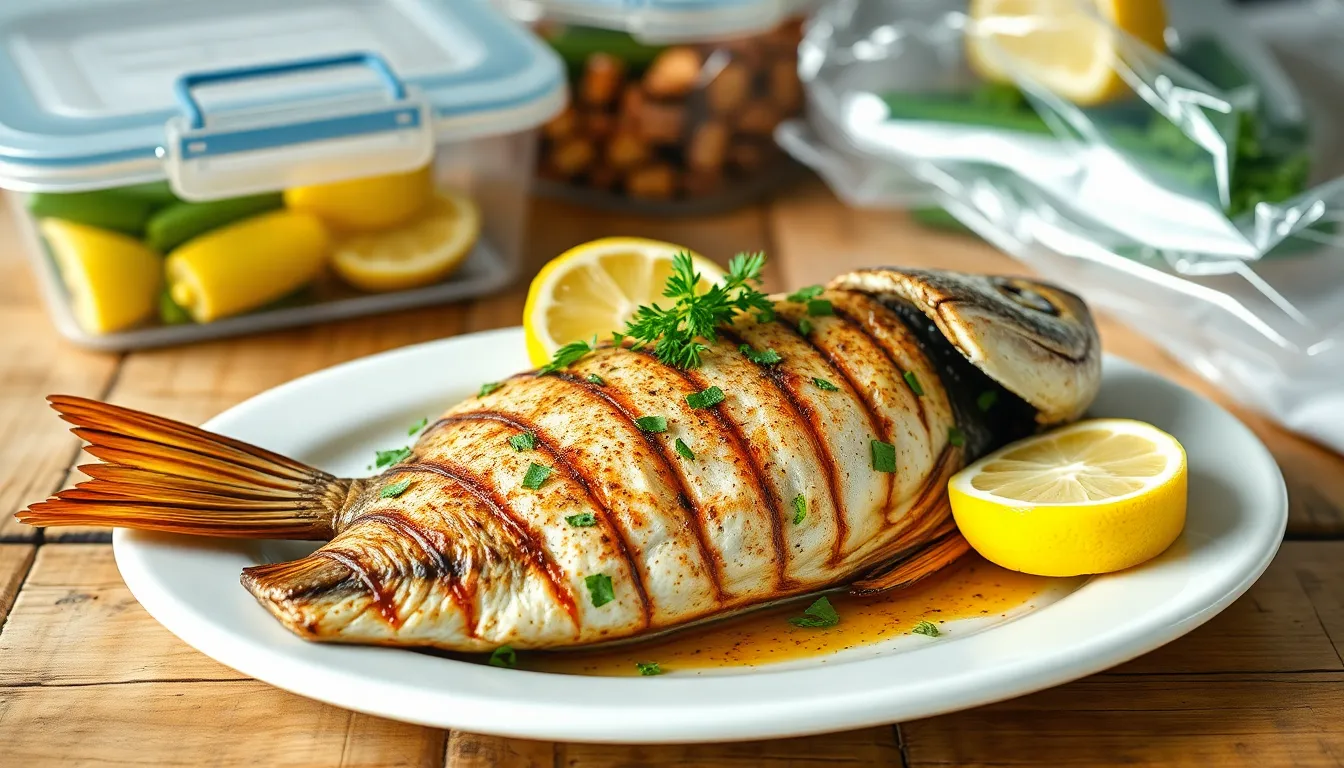
We recommend storing leftover grilled tilefish in airtight containers in the refrigerator for optimal freshness. The fish maintains its best flavor and texture when consumed within 1-2 days of grilling.
Proper Storage Methods
Our testing shows that properly stored grilled tilefish retains moisture and prevents bacterial growth when kept at consistent refrigeration temperatures. We wrap individual portions in plastic wrap before placing them in sealed containers to prevent air exposure. This method preserves the delicate texture and smoky flavors we worked hard to achieve during grilling.
Gentle Reheating Techniques
Low oven reheating produces the best results for maintaining tilefish’s tender flesh. We preheat our oven to 275-300°F and wrap the fish in foil to prevent moisture loss. This gentle approach takes 8-10 minutes and avoids the toughening that occurs with high heat methods.
Microwave reheating works when time is limited but requires careful attention. We use moderate power settings and cover the fish to trap steam. Short 30-second intervals prevent overcooking while ensuring even warming throughout the fillet.
Restoring Crispy Texture
Pan-searing leftover tilefish briefly in butter or olive oil over medium heat revives the exterior crispness. We heat a skillet for 2-3 minutes before adding the fish skin-side down. This technique recreates some of the original grilled texture while adding rich flavor from the cooking fat.
Temperature Safety Guidelines
| Reheating Method | Temperature | Time |
|---|---|---|
| Oven | 275-300°F | 8-10 minutes |
| Microwave | Medium power | 30-second intervals |
| Pan-searing | Medium heat | 2-3 minutes |
We always check that reheated tilefish reaches an internal temperature of 145°F before serving. This ensures food safety while maintaining the fish’s delicate qualities that make our grilled tilefish recipe so special.
Recipe Variations
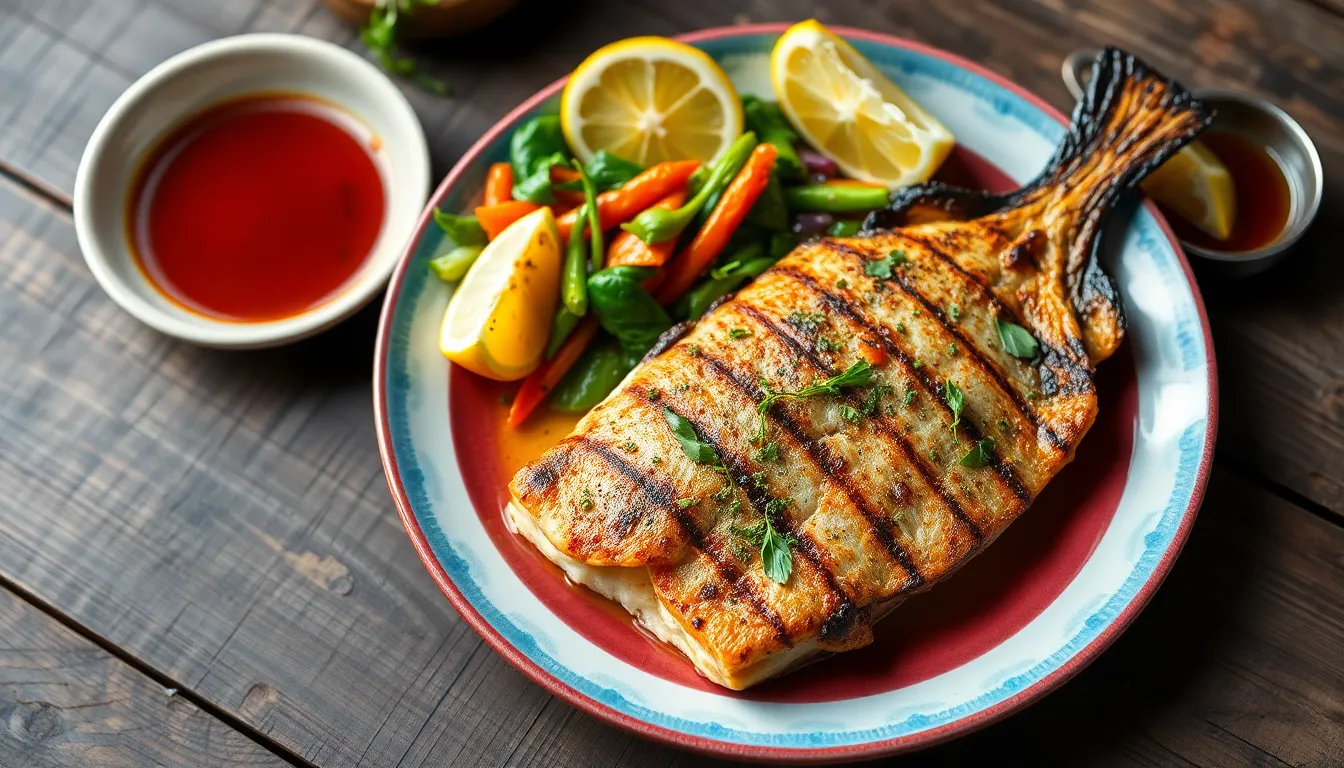
Transform your grilled tilefish experience with these three distinct flavor profiles that showcase the fish’s versatility. Each variation maintains the basic grilling technique while introducing unique seasonings and accompaniments.
Mediterranean Style
We start with our standard 6-ounce tilefish fillets brushed with olive oil and seasoned simply with kosher salt and black pepper. The Mediterranean approach celebrates the fish’s natural sweetness through fresh accompaniments rather than heavy seasonings.
Prepare a vibrant vegetable medley by combining diced zucchini, yellow onions, fresh corn kernels, and climbing beans. Simmer these vegetables lightly with minced garlic and white wine vinegar to create a Southern-style chow chow relish that brightens each bite. Garnish your grilled tilefish with fresh purple basil or cilantro for an herbaceous finish that complements the smoky char.
The key to this variation lies in the balance between the fish’s subtle flavor and the fresh vegetables’ natural sweetness. We recommend serving this alongside grilled lemon wedges and a drizzle of high-quality olive oil for an authentic Mediterranean experience.
Asian-Inspired
For our Asian-inspired variation, we coat the tilefish fillets in seasoned flour mixed with salt and pepper before grilling. This technique creates a golden exterior that holds up beautifully to the bright sauce we pair with it.
Create a light topping by simmering fresh lime juice with diced tomatoes for just 2-3 minutes until the tomatoes soften slightly. This tangy sauce provides the perfect balance of savory and sour flavors that define Asian cuisine. Fresh cilantro adds the essential herbaceous note that ties everything together.
We serve this variation alongside steamed jasmine rice or a light corn salad tossed with sesame oil and rice vinegar. The combination of textures and flavors creates a harmonious dish that highlights the tilefish’s ability to absorb and complement bold flavors without being overwhelmed.
Cajun Spiced
Our Cajun variation transforms the mild tilefish into a bold, Southern-inspired dish through strategic spice application. Create a Cajun seasoning blend using 2 tablespoons paprika, 1 teaspoon cayenne pepper, 1 tablespoon garlic powder, and 1 teaspoon black pepper.
Rub this spice mixture generously on both sides of the tilefish fillets 30 minutes before grilling to allow the flavors to penetrate the fish. The paprika creates a beautiful color while the cayenne adds heat that builds gradually with each bite.
Grill the seasoned fillets over medium heat following our standard technique, but watch carefully as the spices can burn if the temperature gets too high. We recommend serving this variation with grilled vegetables like bell peppers and onions, or alongside a cooling remoulade sauce made with mayonnaise, Creole mustard, and chopped pickles to balance the heat.
Pro Tips for Grilling Tilefish

Our success with grilling tilefish comes down to mastering a few essential techniques that prevent common pitfalls. We always ensure our grill grates are spotlessly clean before cooking to prevent the delicate fish from sticking and tearing when we flip it.
Preheating becomes crucial for achieving that perfect sear. We maintain our grill at medium-high heat between 350°F to 400°F for optimal results. This temperature range creates beautiful caramelization while keeping the interior moist and flaky.
Before placing tilefish on the grill, we brush each fillet generously with oil and season with salt and pepper. This simple step creates a protective barrier that enhances browning and prevents sticking.
Positioning makes all the difference in our grilling technique. We place fish diagonally on the grill with the skin side down and cook for about 3 minutes initially. Testing for readiness involves gently lifting one corner of the fillet. When the fish releases easily from the grates, we know it’s ready to flip.
Timing varies based on thickness, but we typically turn our tilefish every 4-5 minutes. During this process, we brush the fillets with smoked paprika butter for added flavor complexity and visual appeal.
Temperature monitoring ensures food safety and prevents overcooking. We use an instant-read thermometer to check that our tilefish reaches an internal temperature of 145°F before removing it from the grill.
Creating a lemon slice bed underneath the fillets serves dual purposes in our technique. This method prevents direct contact with the grates while infusing subtle citrus aromatics throughout the cooking process.
For enhanced flavor development, we recommend preparing compound butters ahead of time. Mixing softened butter with citrus zest, herbs, or spices allows these flavors to meld and intensify before application.
Alternative cooking methods work well when direct grilling feels challenging. We sometimes wrap tilefish in heavy-duty foil with butter, white wine, seasonings, and vegetables for a more forgiving approach that still delivers excellent results.
Conclusion
We’ve shown you that grilling tilefish doesn’t have to be intimidating. With the right technique and our simple marinade you’ll create restaurant-quality results right in your backyard.
This versatile fish adapts beautifully to different flavor profiles whether you prefer Mediterranean simplicity or bold Cajun spices. The key is maintaining that perfect balance of smoky char and tender flaky interior.
Remember to keep your grill grates clean preheat properly and trust your thermometer. These fundamentals will ensure your tilefish turns out perfectly every time.
Now it’s time to fire up that grill and experience why tilefish is becoming a favorite among home cooks. Your family and friends will be impressed with your newfound grilling expertise.
Frequently Asked Questions
What is tilefish and why is it good for grilling?
Tilefish is a firm white fish with a mild, delicate flavor that’s perfect for grilling. Its texture is similar to grouper or mahi-mahi, and it won’t fall apart on the grill. The fish absorbs marinades beautifully and develops appealing grill marks that add complexity to its flavor while maintaining a moist, flaky interior.
What size tilefish is best for grilling?
Golden tilefish is best for grilling when it weighs between 2 to 10 pounds. Choose thick fillets for optimal grilling results, as they’re easier to handle and less likely to overcook. Thicker fillets also develop better grill marks and maintain their moisture during the cooking process.
What temperature should I grill tilefish at?
Grill tilefish at medium to medium-high heat, around 350°F to 400°F. This temperature range allows the fish to cook evenly while developing a nice caramelized exterior. The internal temperature should reach 145°F for safe consumption, which you can check using an instant-read thermometer.
How long does it take to grill tilefish?
Tilefish typically takes 16-18 minutes to grill without flipping. Cooking time depends on the thickness of the fillet – thicker pieces may need additional time. The fish is done when it reaches an internal temperature of 145°F and the flesh turns opaque and flakes easily.
Do I need to flip tilefish while grilling?
No, you don’t need to flip tilefish while grilling. Cook it on one side for the entire cooking time (16-18 minutes). This method prevents the delicate fish from breaking apart and ensures even cooking. The heat from the grill will cook the fish thoroughly from one side.
What’s the best way to prevent tilefish from sticking to the grill?
Create a bed of lemon slices on the grill grates before placing the fish. This prevents sticking and adds flavor. Also, ensure your grill grates are clean and brush the fish fillets with olive oil or compound butter before grilling. Preheating the grill properly also helps prevent sticking.
How should I season tilefish for grilling?
Season tilefish with sea salt and black pepper as a base. You can enhance flavor with compound butter made from lime zest, lime juice, and coconut, or use a simple marinade of olive oil, salt, pepper, and lemon juice. Avoid over-marinating to preserve the fish’s delicate texture.
What are good side dishes to serve with grilled tilefish?
Pair grilled tilefish with braised kale salad, herby barley salad, or grilled vegetables. Rice pilaf, quinoa salad, and grilled lemon slices complement the fish well. Fresh herbs add brightness, and compound butters like coconut lime butter enhance the delicate flavors without overwhelming the fish.
How do I store leftover grilled tilefish?
Store leftover grilled tilefish in airtight containers in the refrigerator and consume within 1-2 days. Wrap portions in plastic wrap to retain moisture and flavor. For reheating, use low oven temperatures (275-300°F) or pan-sear in butter or olive oil to restore crispy texture.
Is tilefish a sustainable seafood choice?
Yes, tilefish is considered a sustainable seafood choice with healthy population levels. Choosing tilefish supports local fisheries and responsible fishing practices. It’s often considered a hidden gem among commercial fishermen and is gaining popularity in home kitchens as an eco-friendly option.

